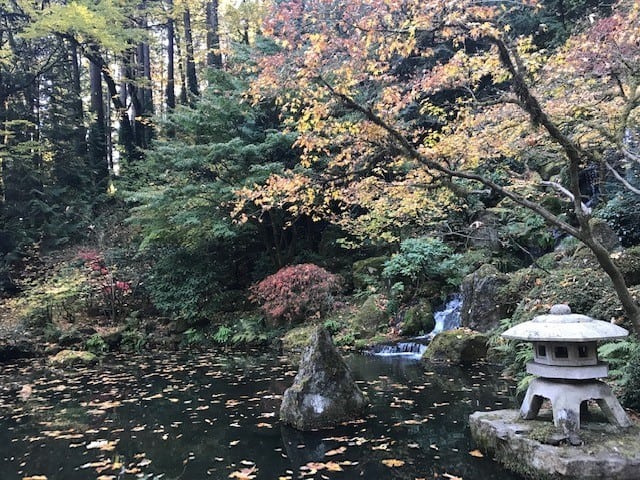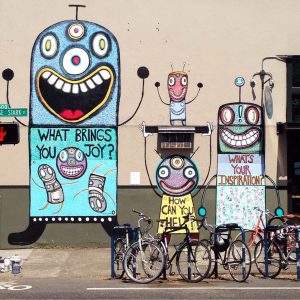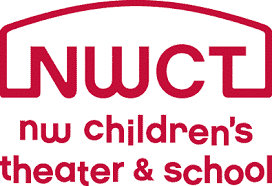
Where education, creativity and joy collide!
The world has changed since I wrote my last introduction to #newsforyourheART. What continues is our mission to include, advocate, support and share arts and culture in our community. We have the opportunity to uplift one another through our voice, our vision, our instrument, and our craft to build bridges, connect, and establish ties that bind. As we enter a new season, we know that we can find joy in the sun, a loving nudge from a dog on a walk, a hug from a friend, an invitation to grab some coffee, and exploring our community, taking in the things we have missed. I invite you to share this newsletter. Share some joy.
– Chanda Evans (she/her), Arts Education Program Manager
Features & Highlights
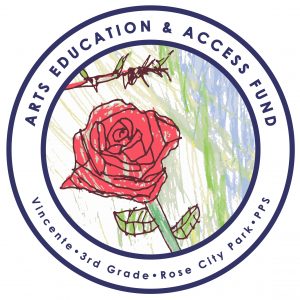
New AEAF logo design by Vincente, a 3rd grade PPS student.
A Reminder that Tax Day is April 18, 2022
Do not forget to remind your neighbors, friends, and family to pay their yearly Arts Education and Access Income Tax Fund (AEAF) Click here to make your $35 payment. To read the recent OP-ED piece in the Portland Tribune by the Chairwoman of the AEAF Oversight Committee, Laura Streib, click here.
Your yearly $35 helps to support arts education in our six school districts- Centennial, David Douglas, Parkrose, Portland Public, Reynolds, and Riverdale. In 2012, residents of Portland passed this measure to provide one arts educator for every 500 students. The fund also supports our community arts nonprofits through grants administered by the Regional Arts & Culture Council (RACC). For more information on the AEAF click here. The AEAF Oversight Committee is the body charged with ensuring compliance of the 2012 measure. Their meetings are open to the public. For more information click here. To pay your $35 online click here. Look on social to repost, tag, and retweet our social media campaign.
#PDXaeaf #CreativeEconomy # WhereArtThouPDX #ArtsEducationForAll #RACCgrants #ArtCreatesHope
________
Legislative Update: Arts Education for All Act & More
On December 9, 2021 the American Academy of Arts and Sciences’ Commission on the Arts stated their case in a Congressional Briefing to two architects of the Arts Education for All Act (H.R.5581), Congresswoman Suzanne Bonamici (D-OR1) and Chellie Pingree (D-ME1). Please watch the video below. If you have not read the Commission’s report Art for Life’s Sake, click here.
Oregon Legislative Session: While H.B.4040 failed to go forward in committee in the 2022 short legislative session, we are hopeful that the importance of arts & culture in our state is not lost on our lawmakers. Please be an ally and support arts & culture and a sustained and fully funded STEAM education in our districts. Contact your state legislators.
________
 Meet Mario Mesquita (he/him/el), RACC’s Advocacy and Engagement Manager
Meet Mario Mesquita (he/him/el), RACC’s Advocacy and Engagement Manager
#writingfromtheheART
Sitting in a local venue of limited yet purposefully crafted libations, in our corner of de-masked friends exchanging briefings of our day, we found refuge in our huddled convening, and I asked: Why is art important to us in this moment? Coming from across the globe, professional backgrounds, career choices, and a myriad of life experiences: heartaches, professional successes, lovers, chosen/family, motherhood, im/migration–what makes art so important that we should not forget?
Art is expression. It is a way that we are able to pass knowledge, tradition, culture, views, and identity to our future selves and next generations. It is a way that we can instill moments in history, learn from the past, and process our current events. Healing.
Art is a way of connecting with family (for better or worse), with our roots, and, for those of us who maintain semblances of connection to our unique heritages, with our nation/s of origin (both pre- and postmodern codified borders drawn out arbitrarily on a map–a design). Art is a way to understand our individual and collective paths. Whether it be through making, experiencing, or observing, through art we get a chance to explore ourselves, to better understand and relate to ourselves as children to adults; to connect with those around us; and to understand the impacts and influences in our lives. Like the corner in the local libation venue, art opens up conversation: how better to hold public space? Art creates space, opens conversation, and can be the place where solutions arise.
“Art” is such a broad term–it encompasses creation from “hand-to-paper,” photography, painting, sculpture, performance, installation, digital recordings, to the literary “arts” (writing, language, and memory)–it seems to be humans’ ability to dream. We can make dreams into reality: capture moments in time, create worlds, envision solutions, magnify and highlight connections, and produce the simplest to the most elaborate designs.
We are solution makers.
It is in this capacity that artists–creative, sensate people–can dream big, think outside the box, and always take a seat at the solution-making table. Not just for cultural planning or skill sharing, but also on decision-making panels–county commission boards, foundations, PTA’s, and city, state, and federal governments. It is important to support and advocate for local and national initiatives that support the arts. We can’t divorce the reaches of art from our current context of an elusive “post-COVID” world, war, the environmental impacts of climate change, political upheaval–the arts offer back to us a space to dream, moments of respite, healing spaces. It is not a wonder that art is recognized for its benefits to mental health.
We need to continue to lobby, support, and advocate ensuring the arts are prioritized in government budget processes and that there continues to be legislation to serve and protect art workers, creatives, and creative economies. Nationally, the Creative Economy Revitalization Act (CERA) is still pending. CERA would get creative workers back into jobs by creating a workforce grants program within the Workforce Innovation and Opportunity Act. The Department of Labor, in cooperation with the National Endowment for the Arts, would administer the grants to government, non-profit, and for-profit organizations. Priority would go to creative workers who became unemployed over the pandemic. Similar to the WPA Federal Project (the Works Progress Administration of 1935), the Creative Economy Revitalization Act would fund creatives to create art that is accessible to the entire community. This can include concert series, large-scale murals, photography exhibits, published stories, and dance performances.
In Oregon, the recent House Bill 4040 would have allocated $50 million to arts and culture entities negatively affected by the pandemic through a grant program administered by Business Oregon. In addition to the funding allocation, the bill would have also provided more specific programmatic guidance for arts agencies while developing the Live Venues and Live Venue Support Businesses program; unfortunately, this bill did not make it through our short legislative session. However, it is important to be aware that parts of the House Bill will be included in upcoming economic recovery initiatives. The bill is still a nod to the importance of the healing capacity of the arts, both for mental health and for economic recovery.
In the city of Portland, the Arts Education and Access Income Tax Fund (AEAF–commonly known by the misnomer “Arts Tax”) was passed by voters in 2012 to support arts education in our schools and arts organizations in our community. The measure funds one arts educator for every 500 students in six school districts in the City of Portland. They include Centennial, David Douglas, Parkrose, Portland Public, Reynolds, and Riverdale school districts. RACC administers grants back out to the community to fund local arts organizations and artists. You can learn more about how the AEAF benefits youth and our future by reading this recently published Op-Ed by Laura Streib, the AEAF Oversight Committee Chairwoman. As my friend said that night in our corner, art allows us “space for questions and possibilities. Art is the public’s record of who we are, can be, and will be.” Advocate, support, show up, and dream. Be a part of the change. For questions about advocacy & engagement with/for/by RACC, please contact Mario Mesquita.
________
A comprehensive curated resource list from RACC’s Arts Education Program is available for download. Click here.
Professional Development: Trauma Informed Care Workshop Series Continues
The Regional Arts & Culture Council, in partnership with Trauma Informed Oregon presents a series of workshops for arts educators. Please join us for our upcoming fourth workshop. This free event will be held in May/June remotely, as we continue to center health and safety for all. Look for our Eventbrite invitation in your inbox if you are a K-12 arts educator.
The Beat: Interviews from the Field
 Meet Kellie McCarty, Theatre Arts Educator from Centennial High School
Meet Kellie McCarty, Theatre Arts Educator from Centennial High School
What inspires you as a high school theatre arts educator? What makes high school a unique space in the realm of arts education? I am inspired daily by my students and by my fellow arts teachers. What we have all just experienced in the past 2 years has been more challenging than anything else in my 26 years of teaching. I am in awe of the creativity and light that was still produced during such a dark time. I saw students take risks every day, and I saw theatre teachers learn new skills to make theatre accessible to their students and their community. It was a true test of the human spirit, and that continues to inspire me every day. High school theatre is unique in that we are working with the artists of the near future. They are going through so much self-discovery as to who they are themselves, and it is amazing to watch them blossom through the journey of creating other characters and sometimes living their shared experiences. Their energy is infectious, and it either keeps me young or ages me very quickly.
What have you learned from your students? What do you want them to take away from your classes when they graduate? I learn something new from my students every day! I think the biggest thing I have learned from my students, though, is their ability to accept each other where they are. I think in education we spend a lot of time focusing on where they are going, such that we sometimes forget to meet them where they are and love them in that moment. My students remind me of that daily. I tell my students on their first day in my class that I am not there to make them the “world’s best actor or technician.” If that happens, great! However, my job is to make sure they are more confident in who they are, and more empathetic to the world and those around them, by the time they leave my class at the end of the year. If that happens, then I consider that a successful year.
What brings you joy when you teach? Some of my most joyful moments as a teacher have been the little things. Like when a student who has struggled with memorization finally gets through their whole performance without pausing. On the other hand, a student who has worked hard on their performance is recognized at Regionals or State. I am also always joyful when the curtain opens on opening night and I get to watch those kids shine in front of their family and friends. I have been very fortunate in my career to have so many joyful moments to remember.
Questions for Humans, Gary Hirsch, mural.
Please share with us by emailing cevans@racc.org.
Please email the Arts Education Program about any summer programming opportunities so we may include them in our short summer one-pager of #newsforyourheART.
If you would like to highlight student work or a recent performance, please share with us! Thank you.
Be sure to check out artlook®oregon to find arts education programing for the summer. Over 250 arts organizations in the tri-county area are listed!
More Interviews from the Field
Featured Arts Organization: 
Northwest Children’s Theatre and School, An interview with
Leigh Mallonee, Education Director
Mission Statement: The mission of Northwest Children’s Theater and School is to educate, entertain and enrich the lives of young audiences.
What are three things you have learned through the years as you worked with youth in theater? They will take you on a more creative and grand adventure than you could ever pre-plan. We refer to our Explore Camps as a week of LARP-ing (live action role-playing). The teachers provide some kindling but the campers light the spark and fan the flames. The characters they
create for themselves, their explanations of “random” events, or their solutions to defeating the villain will always be more creative than anything the adults could think of.
The performance will work out. You may be convinced, based on the 7 weeks of dismal rehearsals that the performance will be a disaster, but when the lights come on and the music starts, they will transform from toads on a log to Michigan J. Frogs singing “Hello My Baby.”
Classroom Management (with a capital C and capital M) does not exist. Theater classrooms are organized chaos. You cannot just announce your four Class Rules and expect students to follow them. The best teachers craft a lesson plan (often on the fly) in which games and activities do the work for them, creating an ebb and flow following or modifying students’ energy levels, and creating moments for all kinds of learners and participants.
Is there a particular performance that resonated with you growing up? Did that experience inspire you to go into the arts? Growing up, my mother and I had a tradition to attend Balanchine’s The Nutcracker every Christmas season. No matter where we were living, we would find a production. I have seen elaborate performances at the Academy of Music in Philadelphia, touring productions in Tacoma, and simple community performances in Nyssa. It was a touchstone in my life; something that I knew would always be there. While it did not inspire me to become a ballerina, it did instill a love of performing arts.
What got me into the theater was my high school drama club. We had recently moved to a small town in Pennsylvania where I did not know anyone. I came home from school every day, crying, convinced that I would never make friends. My parents gave me the ultimatum that I had to join an activity. It did not matter what it was but if I did not pick one they would pick one for me. That day, I came home from school and announced that I had joined the Drama Club. They were shocked. I was shy; I had never set foot on a stage before; I had no obvious musical ability. They were convinced that I had joined Drama Club just to spite them; to fail on purpose and continue to be miserably alone. When they attended opening night of Charlotte’s Web, and the curtain went up and I came on stage, they practically hunched in their seats and covered their eyes. When they heard me deliver my first line as Narrator #1, their jaws dropped. “She’s good!” my step-dad said, but more than that, they were amazed at the transformation – from shy, socially awkward 9th grader to confident and LOUD actor. It was finding a group of silly, passionate, supportive, and equally weird peers, and a drama coach that focused our chaotic energy, that finally made me feel at home in the new school.
How does theatre affect/influence/inspire kids who might not go into the arts or become a theater performer/actor? Not every child who participates in theater will go on to star on Broadway or even be involved in the arts professionally. That is okay! I want classes at Northwest Children’s Theater to be a place for children to experiment, imagine, and explore who they are and what they like. Sometimes what they like will be what they are good at and they will pursue being a theater performer. Just doing something you enjoy, something that gets your creative juices flowing can have immediate and lasting effects. Theater is an art of imagination. It challenges you to think and problem-solve creatively. Unlike the realism of TV or movies, theater requires a different kind of resourcefulness and flexibility. It really taps into your creativity center. Creative dramatics teach children how to collaborate with others, forming a whole out of separate pieces. Musical theater teaches body and spatial awareness. The open-ended and uncertain nature of improv can increase tolerance of ambiguity or making new choices when faced with an obstacle. All of these skills are important whatever a child decides to pursue later on in life.
________
Public Art & Arts Education: A Dive into the RACC’s Public Art Search, Public Canvas Northwest
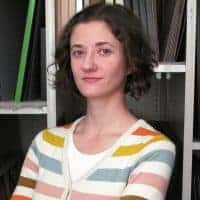 By Danielle Davis, Public Art Collections Registrar
By Danielle Davis, Public Art Collections Registrar
As we head into spring in the COVID-era, it can sometimes be challenging to find things to do to get out of doors and enjoy the sun. Fortunately, the public art collection located in our public spaces across the metro area can provide an opportunity for fun and educational experiences. Owned by the City of Portland and Multnomah County, the public art collection is made up of a wealth of diverse artwork that ranges from prints and drawings, to murals, to large scale outdoor sculptures. One such example is Space Plants by Tyler FuQua Creations, located near the playground in Verdell Burdine Rutherford Park. The artist describes the sculptures as “a family of intergalactic plant-like creatures” that have come to visit Earth. These whimsical and joyful touches to our landscape can provide the perfect destination for a sunny afternoon.

Space Plants, Tyler FuQua Creations. Photo by Jeremy Running Photography.
In my role as Public Art Collections Registrar, one of my biggest tasks is to maintain the data for the collection. From the minute an artwork comes into the collection I do what might be considered a mundane process of cataloging the piece—taking correct measurements (to the closest 1/8th of an inch), making sure the media is recorded with the appropriate data standards, noting any condition problems, and on and on and on. While the word ”data” might make some run for the hills, one significant advantage is being able to provide tools that can help the public go out and see the art. One such tool is a free iPhone app called Public Art PDX. In 2011, developer Matt Blair offered to create an app that maps murals and permanent artwork in the public art collection using data that was made publicly available by the City. Both locals and visitors can use the app to discover art they never knew existed, or perhaps plot a walking tour in any part of town for that fun excursion in the sun.

Con Ganas!, Heysus and Carlos Chavez, mural. Located at 8638 N. Crawford St. in Portland.
RACC has also launched an online search tool that displays all the artwork in the collection. Called Public Canvas Northwest, this online tool provides information on the entire collection, featuring new additions as well as background on significant construction projects such as the Portland Building Renovation. This renovation allowed for the purchase of a group of 2D artworks located on the second floor, as well as the commission of several large-scale pieces. One prime example is We’ve Been Here by Kayin Talton Davis. This mural, located in the Lizzie Koontz Weeks Room, features portraits of black women who have made significant
contributions to the Northwest region yet whose stories have been largely forgotten. More information can be found here. Keep an eye out for new work that will be coming to the building soon.
The Public Art Team at RACC works hard every day to commission, purchase, and maintain this collection to be able to share it with you in new and exciting ways. Take the time to peruse these virtual tools and get out there to explore!
For questions about the collection, contact Danielle Davis.
Workshops • Events • Lectures
Here is a curated list of lectures, workshops, events, and conferences from local colleges and universities. If you know of an event, workshop, performance, lecture, or art exhibition that is coming up please go here to submit an opportunity.
April-May-June
Mt Hood Jazz Festival, Mt Hood Community College- May 6-8th 2022
April is Poetry Month! Check out these events
Literary Arts – Verslandia! Youth Poetry Slam Championship, Arlene Schnitzer Concert Hall- April 28 from 7-9pm
May is Asian Pacific American Heritage and Jewish Heritage Month – check out local events/resources
June is Pride Month: Portland Pride Waterfront Festival and Parade- June 18-19, at Tom McCall Waterfront Park. Click here for a list of local events
42nd Annual Cathedral Park Jazz Festival – Check here for dates in July 2022
Original Practice Shakespeare Festival – check out their 2022 schedule for their free performances in local parks
Piano. Push. Play – Click to find the locations of pianos in our community for 2022
The Scoop – Grow your Brain
 |
Click here for more info. |

|
Click here for more info on Juneteenth.
Click here for local resources. |
 |
Click here for more info on Asian Pacific American Heritage Month. |
 |
Click here for more info. For local resources click here. |
 |
Click here for local LGBTQI resources.
Click here for local youth specific resources. Click here for national resources. |
Regional Arts & Culture Council – Arts Education Program
We welcome feedback and suggestions. Please reach out to Chanda Evans (she/her) at cevans@racc.org
Designed by Andrea Blanco, RACC Communications and Advocacy Design Specialist.
**Featured artwork from RACC’s public art database Canvas NW.
**Some workshops/events/lectures might have changed due to COVID-19. Please check before you make plans.
Disclaimer: The Regional Arts & Culture Council is not held liable for the materials or images in this newsletter.

